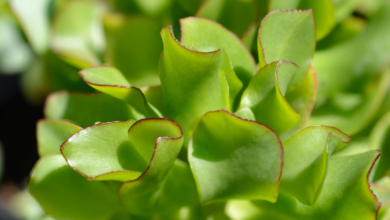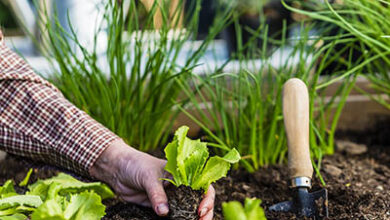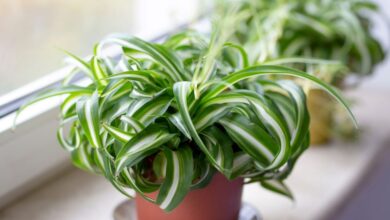Raised garden beds are an excellent option for those who want to control the quality of their soil and have limited space. They are also great for those who have back problems, as they can be built at a comfortable height. Raised garden beds are typically made of wood and can be customized to fit any space. They are also easy to maintain and can be filled with high-quality soil to ensure your plants have all the nutrients they need.
In-Ground Beds
In-ground beds are a traditional option for vegetable gardeners. They are usually dug into the ground and filled with soil. In-ground beds are great for those who have a lot of space and want to plant a large variety of vegetables. However, they can be more difficult to maintain than raised garden beds, as the soil can become compacted over time. It’s important to amend the soil regularly to ensure your plants have all the nutrients they need.
Container Gardening
Container gardening is a great option for those who have limited space or want to grow vegetables on a balcony or patio. Containers can be made of a variety of materials, including plastic, ceramic, and clay. They can also be customized to fit any space. Container gardening is also great for those who want to control the quality of their soil, as they can fill their containers with high-quality soil. It’s important to choose the right size container for your plants and to ensure they have proper drainage.
In conclusion, choosing the right garden bed option is crucial for the success of your vegetable garden. Whether you choose raised garden beds, in-ground beds, or container gardening, it’s important to consider your space, soil quality, and maintenance needs. With the right garden bed option, you can enjoy fresh vegetables all season long.
Preparing and Enriching Soil
As a vegetable gardener, I know that soil is the foundation of any successful garden. Before planting, it’s important to prepare and enrich the soil to give your plants the best chance to grow and thrive.
To start, I recommend testing your soil to determine its pH level and nutrient content. You can purchase a soil testing kit at your local garden center or send a sample to a lab for analysis. Once you know your soil’s needs, you can amend it accordingly.
I like to add organic matter like compost, manure, or leaf mold to my soil to improve its texture and fertility. These amendments also help with water retention and drainage. I usually add a few inches of organic matter to the top of the soil and work it in with a garden fork or tiller.
It’s important to note that some vegetables prefer different soil conditions. For example, tomatoes prefer slightly acidic soil, while carrots like a soil with a neutral pH. Be sure to research the specific needs of the vegetables you plan to grow and adjust your soil accordingly.
Benefits of Organic Mulch
In addition to enriching the soil, organic mulch is another great way to improve the health of your vegetable garden. Mulch is a layer of organic material placed on top of the soil around your plants.
Mulch helps to retain moisture in the soil, which reduces the need for frequent watering. It also helps to suppress weeds, which can compete with your vegetables for nutrients and water.
Organic mulch like straw, leaves, or grass clippings will break down over time and add nutrients to the soil. This makes it a great option for gardeners who want to avoid using synthetic fertilizers.
Mulch can also benefit companion planting. For example, planting marigolds around your vegetables can help to deter pests like nematodes. Mulching with organic matter like coffee grounds or eggshells can also help to repel pests and provide nutrients to your plants.
Overall, preparing and enriching your soil and using organic mulch are two important steps for a successful vegetable garden. With a little bit of effort, you can create a healthy and thriving garden that will provide you with fresh produce all season long.
Plant Selection
When it comes to starting a vegetable garden, choosing the right plants can make all the difference. In this section, I’ll cover two important factors to consider when selecting the plants for your garden: your climate and the benefits of mixing flowers and vegetables.
Choosing Vegetables for Your Climate
Before selecting plants for your garden, it’s important to consider your climate. Different vegetables thrive in different environments, so it’s important to choose plants that are well-suited to your area. For example, if you live in a hot and dry climate, you may want to consider planting heat-tolerant vegetables like tomatoes, peppers, and eggplants.
On the other hand, if you live in a cooler climate, you may want to consider planting cold-tolerant vegetables like lettuces, spinach, and kale. It’s also important to consider the amount of sunlight your garden receives. Some vegetables, like tomatoes, require full sun, while others, like lettuces, can thrive in partial shade.
Mixing Flowers and Vegetables
Another important consideration when selecting plants for your garden is the benefits of mixing flowers and vegetables. Not only can adding flowers to your vegetable garden add beauty and color, but it can also attract beneficial insects like bees and butterflies.
Some flowers, like marigolds, can even help repel pests and protect your vegetables from damage. When choosing flowers to plant in your vegetable garden, consider selecting varieties that are well-suited to your climate and that complement the colors and textures of your vegetables.
By considering your climate and the benefits of mixing flowers and vegetables, you can choose the right plants for your vegetable garden and set yourself up for a successful growing season.
Garden Care

As a vegetable gardener, caring for your garden is essential to ensure a bountiful harvest. In this section, I will cover some of the most important aspects of garden care, including watering, managing pests and pollinators, and crop rotation and succession planting.
Watering Your Garden
Watering your garden is critical to ensure that your plants receive the necessary moisture to thrive. It is best to water your garden early in the morning or late in the evening to reduce water loss due to evaporation. I recommend using a soaker hose or drip irrigation system to deliver water directly to the plant roots, minimizing water waste.
Managing Pests and Pollinators
Pests can be a significant problem in any garden, but there are many ways to manage them without resorting to harmful pesticides. One effective method is to attract beneficial insects, such as ladybugs and lacewings, which feed on pests like aphids and caterpillars. You can also use physical barriers, such as row covers, to protect your plants from pests.
Pollinators, such as bees and butterflies, are essential for many vegetable plants to produce fruit. To attract pollinators to your garden, plant a variety of flowering plants, such as marigolds and sunflowers, and avoid using pesticides that can harm them.
Crop Rotation and Succession Planting
Crop rotation and succession planting are essential to maintaining soil health and maximizing your garden’s productivity. Crop rotation involves planting different crops in the same area each year to prevent soil-borne diseases and nutrient depletion. Succession planting involves planting crops in intervals to ensure a continuous harvest throughout the growing season.
In conclusion, proper garden care is critical to the success of your vegetable garden. By following these tips for watering, managing pests and pollinators, and crop rotation and succession planting, you can ensure a healthy and bountiful harvest.
Garden Design Ideas
As a vegetable gardener, I am always looking for new ways to make my garden both beautiful and functional. Here are a few garden design ideas that I have found to be helpful:
Creating Beautiful and Functional Walkways
One of the easiest ways to add beauty and functionality to your vegetable garden is by creating walkways. Not only do they make it easier to navigate through your garden, but they can also be a great way to add visual interest. Consider using materials such as gravel, flagstone, or brick to create a rustic or modern look. You can also interplant with flowers or use hanging planters to add even more color and texture.
Incorporating Vertical Structures
Vertical gardening is a great way to maximize your garden space and add visual interest. Consider using trellises, obelisks, or ladders to grow vining vegetables such as tomatoes, cucumbers, and beans. You can also use fencing or decorative pots to create a vertical garden that is both functional and beautiful.
Adding Decorative Elements
Adding decorative elements such as borders, terracotta pots, and decorative pots can help to add interest and beauty to your vegetable garden. Consider using a mix of colors and textures to create a unique and eye-catching display. You can also interplant with flowers or create a separate flower garden to add even more beauty to your space.
Overall, there are many different vegetable garden design ideas to choose from. By incorporating walkways, vertical structures, and decorative elements, you can create a beautiful and functional space that you will enjoy for years to come.
Harvesting and Enjoying Your Garden
Best Practices for Harvesting Vegetables
As a vegetable gardener, I find that harvesting is one of the most rewarding parts of the process. When it comes to harvesting vegetables, it’s important to know the right time to pick them. Some vegetables, like tomatoes and peppers, will continue to ripen after being picked, while others, like lettuce and spinach, are best picked when they are fully mature.
It’s also important to use the right tools when harvesting your vegetables. A sharp pair of scissors or pruning shears is ideal for cutting vegetables like lettuce and herbs, while a garden fork or shovel is better suited for root vegetables like carrots and potatoes.
Creating a Salad Garden
One of my favorite things to grow in my backyard vegetable garden is a salad garden. Not only is it easy to grow, but it’s also a great way to have fresh greens on hand all season long.
To create a salad garden, start by selecting a variety of lettuce and other greens, such as spinach, arugula, and kale. Plant them in a sunny location with well-draining soil. Be sure to water them regularly and fertilize them with a balanced fertilizer every few weeks.
Once your salad garden is established, you can start harvesting your greens as needed. To keep your salad garden producing all season long, be sure to harvest the outer leaves of your plants rather than pulling up the whole plant.
Growing Fresh Herbs and Vegetables for the Kitchen
One of the best things about having a backyard vegetable garden is having fresh herbs and vegetables on hand for cooking. Some of my favorite herbs to grow include basil, thyme, and rosemary, while some of my favorite vegetables to grow include tomatoes, peppers, and zucchini.
To grow fresh herbs and vegetables for the kitchen, start by selecting a variety of plants that you enjoy cooking with. Plant them in a sunny location with well-draining soil, and be sure to water and fertilize them regularly.
When it comes time to harvest your herbs and vegetables, be sure to pick them at their peak ripeness for the best flavor. And don’t be afraid to experiment with different recipes and cooking techniques to make the most of your fresh produce.
Gardening Tips for Beginners
As a beginner, starting a vegetable garden can be overwhelming. But with the right tips, you can have a successful garden and enjoy fresh produce all season long.
Start small
It’s important to start small and gradually expand your garden as you gain experience. A 4×4 foot garden bed is a great place to start. This size will allow you to grow a variety of vegetables without feeling too overwhelmed.
Choose the right location
Choose a location that receives at least 6 hours of sunlight per day. Vegetables need sunlight to grow and produce. Also, make sure the location has good drainage to prevent waterlogging.
Prepare the soil
Before planting, prepare the soil by removing any weeds and adding compost or organic matter. This will help improve soil fertility and drainage.
Plant at the right time
Different vegetables have different growing seasons. Some are best planted in the spring while others are best planted in the fall. Make sure you research the growing season for each vegetable before planting.
Proper spacing
Proper spacing is crucial to ensure healthy growth and maximum yield. Make sure to follow the spacing requirements for each vegetable. Overcrowding can lead to poor growth and disease.
Watering
Water your garden regularly, especially during hot and dry weather. A good rule of thumb is to water deeply once a week rather than shallowly every day. This will encourage deep root growth and help your plants withstand drought.
By following these tips, you can have a successful vegetable garden and enjoy fresh produce all season long. Happy gardening!




